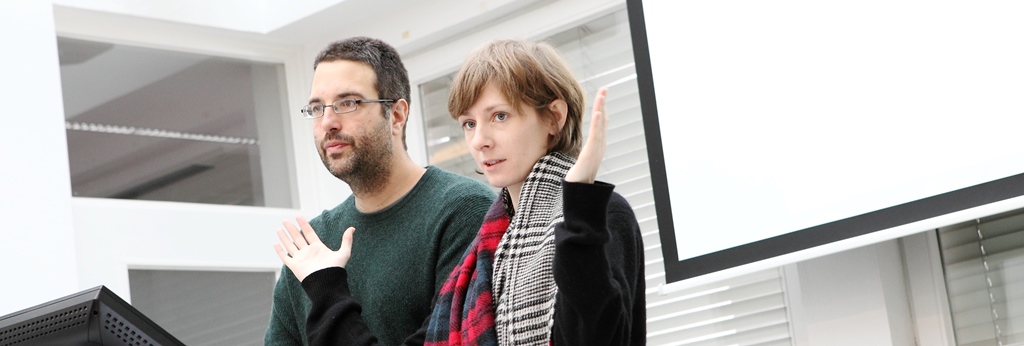Challenging questions at the intersections of art, pedagogy, and research
An Interview with microsillons (Marianne Guarino-Huet and Olivier Desvoignes) by Laila Huber and Elke Zobl
Would you say it is an intervention, in the sense of intervening into the museum context?
Marianne Guarino-Huet: With this project, at least, we can definitely say that it is really a way to intervene and also to interrupt the “usual.”
Olivier Desvoignes: Not only in the museum context: when we used it for two projects in Rome and in Geneva, in the streets, it was definitely an interventionist practice.
In both cases we didn’t ask for any authorization, so both actions were pirate events in the street and because the structure was so light, we could move quickly and we never had any trouble. In Rome we found a closed travel agency and we decided, just passing by, that we would do an exhibition on the window, so we just stopped in front of it and for a few hours we designed the exhibition and put everything on the store-front. So it definitely has the potential to be an interventionist toolbox.
Marianne Guarino-Huet: After each experiment we did with the mobile office, in public space, we printed a poster, which is also a way to keep track of those interventions. The posters are just printed on demand, but we produce the pdf and it can be reprinted. It is also a nice way for us to talk about the idea of mobility because it is genuinely a reproducible object that can be displayed in different places.
And is there only one mobile office? Or are there several versions meant to be used by different people?
Olivier Desvoignes: There are two modules that can connect because we can carry one each, but in fact, the idea is the opposite: in the project concept, in the beginning it was meant to diminish. The idea is that each time we use it, we lose some parts. The idea is that it does not become a model, but instead, an experiment that will eventually disappear.
Marianne Guarino-Huet: It was very important for us to also have that financial support, to be able to buy a computer, for example. But it is not meant as a kit that we could develop.
Since our topic here is artistic interventions, could you explain what artistic intervention means to you? Do you see your work or perhaps specific projects as artistic interventions?
Marianne Guarino-Huet: The question is about defining art. We were both trained as artists and we consider our practice an artistic practice, which does not mean that we can’t say it is art education, but for us the umbrella “art” is really useful because it allows a lot of freedom. Art education and a critical art education as it was developed in Vienna in the 1990s are not present in French speaking Switzerland. The “Institute for Art Education” is really an island in Zurich and it is really nice when you are on that island and when you talk with the people there. But when you go out in Geneva, the art education programs of the institutions are classical. So, for us, the idea of a different art education is very important also in that context.
Olivier Desvoignes: But regarding the term “intervention,” certainly some other of our projects could enter this definition, “Notes of possible future uses of the Gdansk shipyard,” for example, is a project where we worked on the production of posters as a counter proposal to the plan of the promoter for a new city in the former shipyard of Gdansk. It was a work of inquiry with different people and the production of a counter proposal, via a poster that was distributed in the city. We also worked around the practice of craftivism, which definitely lays in the tradition of interventionist art. There is always a bit of an idea of “Störung [disturbance]” when we are working with institutions. There is very often a critical dimension, but maybe not always in an interventionist sense. When we are hired by an institution, it is difficult to call our projects interventions, when in truth, is they are planned well in advance and supported by the institution.
Marianne Guarino-Huet: The core is how to articulate these artistic practices and educational practices together to develop projects; then, sometimes it takes a more interventionist approach, sometimes it doesn’t. And about the art in it, well, for us it is more about the context. It is also about the role that you are adopting with a group: when we collaborate independently we present ourselves as artists and when we are invited by institutions, it might be as artists or as critical gallery educators.
Olivier Desvoignes: But we are not always attempting to integrate artworks, for example, with “Groupe l’Aventin” (http://iae-journal.zhdk.ch/no-8/texte/): The theater play was “Antigone,” so we could easily find a lot of representations of “Antigone” and, starting from there, reflect on the visual part of the play. But we wanted to go further and the results with the two groups—a series of objects inspired by craftivism and a video, had little to do with that initial input of the Antigone representations. We do not force the production of an artwork that will be perceived as such. It is not important for us.
Laila Huber, Elke Zobl, microsillons – Olivier Desvoignes/Marianne Guarino-Huet ( 2014): Challenging questions at the intersections of art, pedagogy, and research. An Interview with microsillons (Marianne Guarino-Huet and Olivier Desvoignes) by Laila Huber and Elke Zobl . In: p/art/icipate – Kultur aktiv gestalten # 05 , https://www.p-art-icipate.net/challenging-questions-at-the-intersections-of-art-pedagogy-and-research/


 Artikel drucken
Artikel drucken Literaturverzeichnis
Literaturverzeichnis